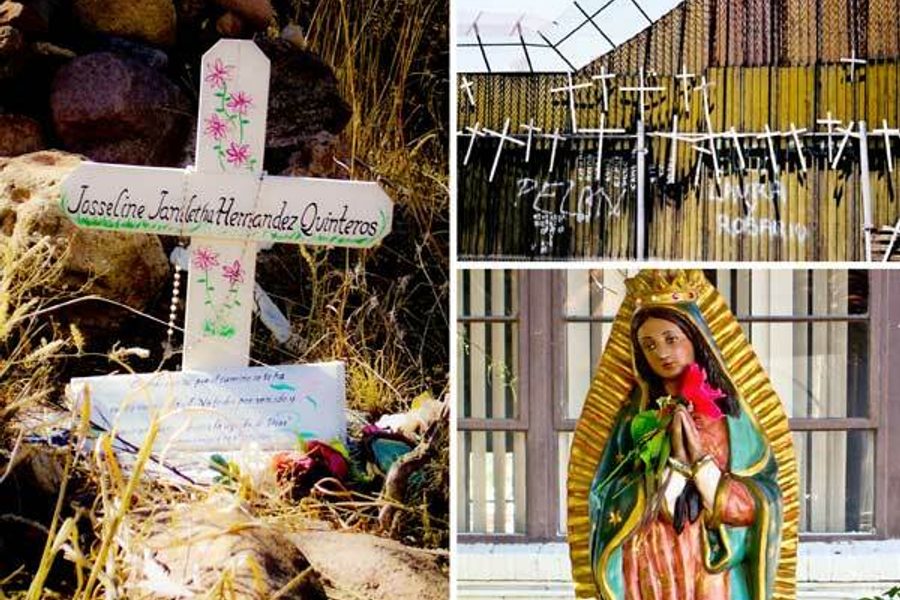
Do you have any children?” I ask Alicia. She says no, then remains silent, eyes fixed on the car in front of us. She was discharged from the hospital two days before, leaving behind the remains of her baby that had been born dead less than a week after she began her trek through the desert.
Sitting at a stoplight, I glance sideways at her. Wavy black hair reaches below her waist. She is pretty in a scrubbed-clean, sad way. There is no light in her eyes.
We are on our way to the Mexican consulate. The consulate will make arrangements for transfer of the baby’s body from the hospital to the funeral home, the final destination for far too many border crossers. It will cover the cost for cremation of the infant and will help her get papers so she can take the ashes back to Mexico.
At home in Michoacán she had helped support her mother, sisters and an eight-month-old nephew. Her 15- and 16-year-old sisters were still in high school and did not work. The family wanted them to graduate since Alicia had not had the opportunity to advance past primary school. She had worked in a Coca-Cola plant making $65 a week for seven years. It was hard work, but steady. Sometimes she worked from six in the morning until 10 at night, working overtime to make extra money. But then the plant closed, and she was only able to get temporary work.
Her grandfather was diagnosed with cancer, treatment was very expensive, and he accumulated a lot of medical bills. Alicia’s severance pay from the Coca-Cola plant was used to pay for his care. Her mother made $40 per week cleaning houses. There was not enough money to support the family, so 28-year-old Alicia headed north to earn more money. Six months pregnant, with the promise of a job picking fruit in Oregon, she set out on her journey.
The father of her baby, a man she had been with for two years, was not upset when she phoned him that the baby was stillborn. She says he wasn’t even sad when she left to come north al otro lado (to the other side). He was, she says, “a type of man who would go out and look for other women.”
Alicia and I sit in the office of the consulate. People move back and forth between the rooms. Amid all the bustle, Alicia looks out of place. At a corner desk a pretty young woman with dark hair and perfectly arched eyebrows helps Alicia. She is sympathetic.
Her job at the consulate is to help Mexican nationals who had been hospitalized. On the wall behind her desk was a large board with posted information regarding several patients in various hospitals. The board is marked off in quadrants. The seriousness of the medical condition worsened top to bottom, while the likelihood of survival declined left to right.
In the top left quadrant was Imelda. Her diagnosis: dehydration. In the bottom left was José Nicolás Alvarez, who was admitted to the hospital with a fractured leg. In the top right was Candelar’a Ortega Mendoza, a 30-year-old woman. Diagnosis: dehydration. She required dialysis every day because of renal failure. Walking for days in the desert in blistering heat, one becomes severely dehydrated, causing muscle cells to break down. The protein from these cells gets into the bloodstream and circulates through the body, becoming trapped in the microscopic tubules of the kidneys and causing the organs to shut down.
In the same quadrant with Candelar’a’s information was written in brackets, “Samaritans will help with her.” I was taken aback. How could we help? The help of Samaritans lies in trying to prevent kidney failure, prevent dehydration that results in renal shutdown. We take water to the desert crossers before they need to go to the hospital. We bandage blistered feet, splint sprained ankles and rehydrate those who have been vomiting from drinking cattle-tank water. We encourage those who cannot keep up with their group to go back rather than risk a journey with Santa Muerte–Saint Death. The patient was on dialysis. What could Samaritans do?
I look back to the dry erase board. In the bottom right quadrant of the board was the last patient, Francisco Portes de la Peña. Date of birth: April 19, 1964. Diagnosis: fractured hip and cerebral lesions. Below, written ominously: “Unconscious – on respirator.”
Alicia explains to the woman at the consulate the progression of events resulting in her hospitalization. When she began her journey, six months pregnant by her estimate, she felt the movement of her baby. But several days of walking in the scorching desert sun took its toll: dehydration with symptoms of dizziness, nausea and weakness. One day she felt the kicking and the next day, no movement at all. Then she began to feel sick. She became very alarmed when her water broke. She pantomimes the gush of amniotic fluid.
Two women traveling with her group of 20 stayed with her when she was abandoned by the rest of the group and the coyote, a smuggler paid to guide them through the desert. The three of them flagged down help and were finally picked up by the border patrol. Alicia was taken to the hospital, and her friends were immediately deported.
In the air-conditioned office, the forms are completed. Alicia signs an affidavit as to her identity, having lost her identification papers in the desert. They assure her they will call when the ashes could be picked up.
Fifteen days later, I return to the consulate to pick up the ashes of baby bo Ortiz. Alicia has already been deported, but I had promised to mail the ashes so he can be buried in Mexico. Waiting on the paperwork, I am once more sitting in front of the corner desk looking again at the board on the wall. It is empty. I wonder if that means there are no Mexican nationals in the hospital. What happened to the four who were on this board two weeks ago?
The patient on the respirator probably died. The two who were in the first tier probably had been discharged. What about the woman on dialysis? Perhaps she recovered and was sent back home to Mexico. If so, I hoped that she lived in a city large enough to provide good medical care.
To the left of the blank dry erase board was a large square portrait of Benito Juárez, less Indian-appearing than most pictures of the mid-19th-century Mexican president. To the left of Juárez was a black-and-white poster with three crosses and a cemetery with gravestones. Across the picture of the crosses was written in Spanish “¡No expongas a los tuyos! ¡No dejes tu vida en el desierto!” (“Do not put yourself at risk! Do not die in the desert!”)
An official comes to the door and beckons me inside his office. He hands me the ashes in a little black box with a file folder label taped on it: “José Ortiz Mendoza.” I take it home to wait for the proper paperwork from the consulate before mailing the small container. I placed it on a ledge over the kiva fireplace in my living room, beside the urn for my own ashes.
This essay is adapted from Crossing with the Virgin: Stories from the Migrant Trail (University of Arizona Press, 2010).





